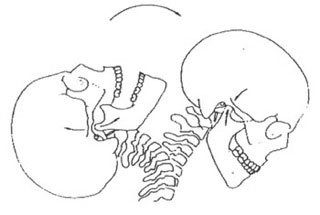By Barry Keate
Barry Keate, has lived with tinnitus over 40 years and has published 150+ research articles on numerous aspects of tinnitus. He is an expert on the condition and a well-known advocate for those with tinnitus.
In Part One of this article, we discussed Traumatic Brain Injury (TBI). In the final installment of the article, we will discuss whiplash injury, instability of the craniocervical junction and Chiari Malformation.
The most common cause of tinnitus is exposure to noise, with approximately 70% of people with tinnitus having noise-induced hearing loss. Somewhat surprisingly, the second most common cause is head and neck injuries. In a clinical study of 2,400 tinnitus patients at the Oregon Health Science University, more than 12% reported that their tinnitus had been caused by head or neck injury. (1)
There are two broad categories of head and neck injury, Traumatic Brain Injury (TBI) and whiplash. Two other, somewhat rare conditions are part of the complex of head and neck injuries. These are instability of the craniocervical junction at the top of the spine and Chiari Malformation, a congenital defect in the base of the skull.
Whiplash
Whiplash is a non-medical term describing a range of injuries due to sudden distortion of the neck. Cervical Acceleration-Deceleration (CAD) describes the mechanism of action while the term Whiplash Associated Disorders (WAD) describes the injuries and symptoms.
Whiplash is commonly associated with vehicle accidents, usually when the vehicle has been hit in the rear. Whiplash injury can occur at speeds of fifteen miles an hour or less. It is the sudden jolt that causes the head to be abruptly thrown back. The more sudden the motion, the more bones, discs, muscles and tendons in the neck and upper back will be damaged.
Whiplash is one of the most common nonfatal car accident injuries. Over 1 million whiplash injuries occur each year due to auto accidents alone. Spinal cord injuries from whiplash are responsible for 6,000 deaths in the US each year and 5,000 cases of quadriplegia (paralysis in all four limbs). (2)
Whiplash may be caused by any motion similar to a rear end collision, such as on a roller coaster or other rides in an amusement park, sports injuries such as skiing accidents or from being hit, kicked or shaken. Shaken baby syndrome can result in whiplash injury. (3)
In whiplash injury, the trunk is suddenly projected forward and the head, because of its inertia, is violently thrown backward (unless an adequate headrest is present). Therefore, a hyperextension of the head on the neck is produced. When the maximum extension is attained, the movement is transformed into a forward displacement, or hyperflexion. Both hyperextension and hyperflexion are conditions where the movement of the head and neck are beyond their normal range of movement. In the hyperextension phase, the jaw is flung open and elongates the Temporo-Mandibular Joint (TMJ). In the hyperflexion phase, there is a sudden closure of the mouth and the Temporo-Mandibular Joint is compressed.
In addition to damage to the TMJ, the cartilage between the vertebra, the discs, ligaments, neck muscles and nerve roots may become damaged.

About 80% of the cases of whiplash injuries recover within a few months. However, about 15-20% (about 40,000 cases per year) develop “late whiplash injury syndrome”. This syndrome involves complaints including neck pain, headache, vertigo, hearing loss and tinnitus. (4) Hearing loss, tinnitus and dizziness are the main ontological symptoms of whiplash. (5) TMJ dysfunction is also common in cases of whiplash injury. (6)
TMJ dysfunction is a common cause of tinnitus and was discussed in an earlier article.
Treatment of whiplash in most medical clinics centers around managing the soft tissue pain that normally occurs after whiplash. Over-the-counter and prescription painkillers, injections of lidocaine to numb painful muscles, and muscle relaxants are all normally used.
Soft foam cervical collars were once commonly used for whiplash injuries, however they are no longer routinely recommended. Immobilizing the neck for long periods of time can lead to decreased muscle bulk and impair recover. (7)
Other therapies include the use of ice, heat, manual therapies including deep tissue massage, and ultrasound.
One very interesting clinical study shows that acupuncture is very helpful for whiplash injuries. Twenty-seven patients were given acupuncture and compared with a control group that used non-steroidal anti-inflammatory medications. The results showed a high percentage of positive results over medication. (8)
Claus Claussen, MD is professor extraordinarius of Neurotology at Wurzburg University in Germany. He is one of the world’s leading experts on whiplash and the otological symptoms of whiplash including tinnitus and balance disorders. He has stated, “When tinnitus is resolved, either through the application of intravenous Ginkgo biloba or electrical stimulation, brain waves normalize and vertigo resolves as well. The lesions that cause tinnitus and vertigo are in the same area of the brain.” He stated without reservation that Ginkgo biloba can resolve tinnitus.
Craniocervical Junction
The craniocervical junction refers to the junction of the skull where it meets the neck. Because of the complex of nerve fibers and blood vessels in the region and the flexibility of the cervical spine, craniocervical tissues are particularly vulnerable to a variety of compression and traction disorders.
Patients with instability of this junction may be suffering from degenerative changes in the upper spine. However, many patients present with late complications after accidents. Patients with degeneration in the lower cervical spine rarely report tinnitus but the patient group with instability at the craniocervical junction usually report a high-pitched whistle, which can be in one or both ears. Patients who have dysfunction at C2-C3 or C3-C4 mostly had tinnitus that sounded like splashing or crackling noises.
Between January 1996 and January 2000, authors of a clinical study operated on nearly 150 patients per year who had craniocervical joint dysfunction. After operative correction and rehabilitation, the tinnitus disappeared completely and permanently in all but two patients. (9)
Chiari Malformation
Chiari is a congenital condition where the cerebellum (lower part of the brain) and the brain stem herniate into the cervical spinal cord. The two main types of Chiari malformation are Type I (adult) and Type II (pediatric). (10)

Symptoms of Type I Chiari malformation usually occur between the ages of 25 and 45. The classic symptom of this malformation is headache, often severe. The headaches are usually brought about by sudden coughing, sneezing or straining. Other symptoms include neck pain, balance problems, numbness, dizziness, blurred vision and tinnitus.
In Type II Chiari malformation, a greater amount of tissue protrudes into the spinal canal. This is because the backbone and spinal canal have not closed properly before birth.
Type III Chiari malformation is a more severe type of the condition. In this case, a portion of the cerebellum protrudes through an opening in the back of the skull.
Type IV Chiari malformation is the most severe. In this case, the brain itself has never developed normally.
Currently, there is no consensus among specialists in the field about how to best treat the condition. The most effective treatment for Type I Chiari malformation is surgical decompression of the foramen magnum, the opening at the bottom of the skull leading to the spinal cord.
References
1 – Folmer RL, Griest SE. Chronic tinnitus resulting from head or neck injuries. Laryngoscope 2003 May;113(5):821-7.
2 – http://en.wikipedia.org/wiki/Whiplash_(medicine)
3 – Medline Plus Encyclopedia Whiplash (http://www.nlm.nih.gov/medlineplus/ency/article/000025.htm)
4 – Claussen, C. –F. Constantinescu, L. Tinnitus in Whiplash Injury. International Tinnitus Journal, Vol. 1, No. 2 – July/Dec, 1995.
5 – Trantor RMD, Graham JR. A Review of the Otological Aspects of Whiplash Injury, J Forensic Legal Med, September 6, 2008.
6 – Boniver, R. Temporomandibular Joint Dysfunction in Whiplash Injuries: Association with Tinnitus and Vertigo. International Tinnitus Journal, Vol. 8, No. 2 – July/Dec, 2002.
7 – http://www.myoclinic.com/health/whiplash/DS01037/DSECTION=treatments-and-drugs.
8 – Fattori B, Ursino F, et al. Acupuncture Treatment of Whiplash Injury. International Tinnitus Journal, Vol. 10, No. 2 – July/Dec, 2004.
9 – Montazem A. Secondary Tinnitus as a Symptom of Instability of the Upper Cervical Spine: Operative Management. International Tinnitus Journal, Vol. 6, No. 2 – July/Dec, 2000.
10 – http://mayoclinic.com/health/chiari-malformation/DS00839/DSECTION=symptoms.
Get Free Shipping!
Order now and get free shipping on either the Tinnitus Starter Kit or Combo Pack. Try the doctor recommended products with clinically proven ingredients for tinnitus. No coupon code required.

